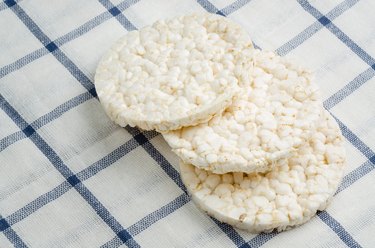
There are healthy snacks and unhealthy snacks, and then there are snacks that are in between. Puffed rice has some carbs, some calories, some nutrients and very little fat, so it can be a somewhat healthy snack to munch on as long as it doesn't have a lot of unhealthy additives.
A staple in India and other Asian cuisines, puffed rice, or "mumra" as is it is also known, is made of rice kernels that have had air introduced to them to make them larger, lighter and crispier. A study published in the International Journal of Food Properties in June 2016 notes that the puffing process involves several steps: The rice is parboiled, dried, milled, treated hydrothermally and then popped.
Video of the Day
Video of the Day
According to the authors of the study, changing the rice grain from a compact structure to an expanded one alters its physical properties and nutrition profile considerably.
Read more: Which Rice Is Healthiest for Consumption?
Puffed Rice Calories
According to the USDA, 1 cup of puffed rice has 70 calories. The majority of the calories in puffed rice are from carbs, since 1 cup (17 grams) of puffed rice has 15 grams of carbs, 1 gram of protein, zero grams of fat and zero grams of fiber.
Since puffed rice doesn't have a lot of calories and is low in fat, it can be a good option if you're trying to lose weight. The Mayo Clinic suggests that if you're on a diet, you should opt for snacks that provide 100 calories or less to keep you going between meals.
While you should ideally pick snacks that also deliver a lot of nutrition, puffed rice can give you the satisfaction of having eaten something, which can help take the edge off your hunger and prevent you from overeating at mealtime.
Puffed Rice Nutrition
Puffed rice that is made of white rice is not very nutritious. According to the University of Arkansas, the husk, bran and germ layers are removed when white rice is processed, stripping away the antioxidants, fiber, vitamins and minerals that naturally occur in rice.
According to the USDA, 1 cup of puffed rice has 5.4 milligrams of iron, 45 milligrams of potassium and small amounts of B vitamins. Fortified varieties of puffed rice have more nutrition. The University of Arkansas notes that brown rice is rich in B vitamins, vitamin E, minerals and fiber because it is a whole grain that retains its bran and germ layers. Puffed rice made from brown rice is therefore a much healthier option.
Read more: How Is White Rice Healthy for Our Body?
The June 2016 study published in the International Journal of Food Properties found that the popping process enhanced the nutritional value of puffed brown rice because the nutrients from the husk were transferred to the grain during the parboiling step of the process. The study lists potassium, phosphorus, magnesium, calcium, iron and zinc as some of the nutrients in puffed brown rice.
Puffed Rice and Diabetes
A study published in Cogent Food & Agriculture in November 2015 notes that puffed rice is included in breakfast cereals, snacks and other foods as a major source of carbohydrates. However, eating puffed rice if you have diabetes means being much more mindful of how you eat it. Here are some ideas for how to eat puffed rice if you have diabetes.
Like popcorn, another whole grain that has been puffed, puffed brown rice can be a part of a person with diabetes' diet if it is eaten right. The USDA recommends eating air-popped corn that is flavored with dried herbs and a spritz of olive oil instead of butter, margarine, salt, sugar and other unhealthy ingredients. Following the same guidelines for puffed brown rice can help you incorporate it into your diet.
Read more: 7-Day Brown Rice Diet
Avoid puffed rice preparations that have added sugar and opt for combinations that have protein or healthy fats instead. Meals with protein and fat slow down the rate at which carbs are converted to blood sugar.
Harvard Health Publishing recommends combining more than one macronutrient to make a healthy snack and promote satiety. So you can pair puffed rice cakes with peanut butter for example, or saute puffed rice with a dash of olive oil, salt, spices and nuts.
- International Journal of Food Properties: “Process Optimization and Characterization of Popped Brown Rice”
- Mayo Clinic: “Snacks: How They Fit Into Your Weight-Loss Plan”
- USDA: “Puffed Rice”
- University of Arkansas: “Choosing the Best Rice for Your Cooking Needs”
- USDA: “Is Popcorn a Healthy Snack? It Can Be!”
- Cogent Food & Agriculture: “Assessment of Suitability of Selected Rice Varieties for Production of Expanded Rice”
- Harvard T.H. Chan School of Public Health: “Carbohydrates and Blood Sugar”
- Harvard Health Publishing: “7 Ways to Snack Smarter”